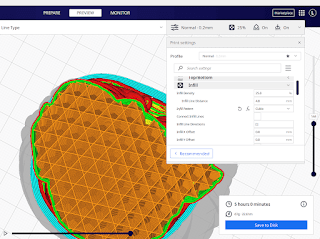This article is brought to you by Lizzsews.
Infill -> what keeps the print stable internally. It helps with crush resistance although cannot help with snapping. It is the inside of a 3D print.
But what is the strongest infill pattern?
The strongest infill pattern for 3D printing is known as the cubic pattern, also known as the honeycomb pattern. It's a 3D pattern of stacked and tilted cubes that takes up a large amount of space within the model. It's supportive and has a higher density than most other infill patterns.
As it is the strongest, that also means that it takes a longer time to print with and has a higher production cost.
This infill pattern should be used for functional 3D prints, where good strength is required in multiple directions, or prints that will be under any pressure that need some strength. An infill density of 50%-100% should be used for best results.
Recommended read: What I use to slice my 3D print files
Leave a comment below and let me know what your next print will be! And don't forget to subscribe to stay up to date with all of Lizzsews new articles. See you next time!

Comments
Post a Comment